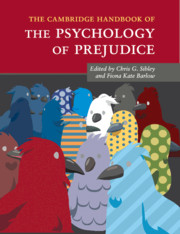Book contents
- Frontmatter
- Dedication
- Contents
- List of Figures
- List of Tables
- Notes on the Contributors
- Part I General Theoretical Perspectives
- Part II Prejudice in Specific Domains
- Part III Prejudice Reduction and Analysis in Applied Contexts
- 20 Recent Developments in Intergroup Contact Research: Affective Processes, Group Status, and Contact Valence
- 21 From Prejudice Reduction to Collective Action: Two Psychological Models of Social Change (and How to Reconcile Them)
- 22 Self-Regulation Strategies for Combatting Prejudice
- 23 Antecedents and Consequences of Evaluative Concerns Experienced During Intergroup Interaction: When and How Does Group Status Matter?
- 24 Stereotypicality Biases and the Criminal Justice System
- 25 Prejudice, Stigma, Bias, Discrimination, and Health
- 26 Development of Delegitimization and Animosity in the Context of Intractable Conflict
- 27 Interventions in Real-World Settings: Using Media to Overcome Prejudice and Promote Intergroup Reconciliation in Central Africa
- 28 Identification with All Humanity: The Antithesis of Prejudice, and More
- 29 It's All About Ignorance: Reflections from the Blue-eyed/Brown-eyed Exercise
- Index
- References
23 - Antecedents and Consequences of Evaluative Concerns Experienced During Intergroup Interaction: When and How Does Group Status Matter?
from Part III - Prejudice Reduction and Analysis in Applied Contexts
Published online by Cambridge University Press: 17 November 2016
- Frontmatter
- Dedication
- Contents
- List of Figures
- List of Tables
- Notes on the Contributors
- Part I General Theoretical Perspectives
- Part II Prejudice in Specific Domains
- Part III Prejudice Reduction and Analysis in Applied Contexts
- 20 Recent Developments in Intergroup Contact Research: Affective Processes, Group Status, and Contact Valence
- 21 From Prejudice Reduction to Collective Action: Two Psychological Models of Social Change (and How to Reconcile Them)
- 22 Self-Regulation Strategies for Combatting Prejudice
- 23 Antecedents and Consequences of Evaluative Concerns Experienced During Intergroup Interaction: When and How Does Group Status Matter?
- 24 Stereotypicality Biases and the Criminal Justice System
- 25 Prejudice, Stigma, Bias, Discrimination, and Health
- 26 Development of Delegitimization and Animosity in the Context of Intractable Conflict
- 27 Interventions in Real-World Settings: Using Media to Overcome Prejudice and Promote Intergroup Reconciliation in Central Africa
- 28 Identification with All Humanity: The Antithesis of Prejudice, and More
- 29 It's All About Ignorance: Reflections from the Blue-eyed/Brown-eyed Exercise
- Index
- References
Summary
Individuals often evidence substantial egocentrism by virtue of being preoccupied with themselves and how they appear to others during social interaction. For example, people overestimate the extent to which others’ behavior is caused by and directed toward them personally (Zuckerman et al., 1983), perceive that others pay more attention to them than is actually the case (Gilovich, Medvec, & Savitsky, 2000), and even exaggerate others’ focus on their failures and mishaps (Savitsky, Epley, & Gilovich, 2001). Such egocentric biases may sometimes seem counterintuitive, as when they lead individuals to reach overly pessimistic conclusions about how they are viewed. However, the biases are readily understandable through the lens of contemporary theories emphasizing how individuals’ fundamental motivation to maintain a sense of belonging and acceptance leads them to continuously monitor their social standing with others (e.g., Leary & Downs, 1995).
Critical from an intergroup relations perspective is that individuals do not leave this motivation for social acceptance – or the egocentric biases that it fosters – behind when they enter intergroup interaction situations. Although myriad forces are of course operative in these settings, individuals’ basic human desire to understand and manage their social standing with others remains very much in play.
What does this mean for intergroup relations? The information search model (Vorauer, 2006) drew on existing research and theory to make a range of predictions regarding antecedents and consequences of evaluative concerns during intergroup interaction. A key premise of the model was that these concerns could have a variety of negative implications for intergroup relations. Although at the time clear evidence supported of some of the model's propositions, other propositions were largely speculative. In the decade or so since then, research has been conducted that speaks to many of these originally untested, or sparsely tested, ideas, and more data from members of minority or lower-status groups are available now than was initially the case.
Accordingly, we review the new research and assess the extent to which the findings support versus contradict key propositions of the model. Because of space limitations, we focus on group memberships defined by ethnic background and broad themes, especially with respect to consequences. We place particular emphasis on the evidence for similarities versus differences across members of higher- and lower-status groups. We conclude by considering implications for intervention and identifying what we see as important next steps for research in this area.
- Type
- Chapter
- Information
- The Cambridge Handbook of the Psychology of Prejudice , pp. 519 - 541Publisher: Cambridge University PressPrint publication year: 2016



